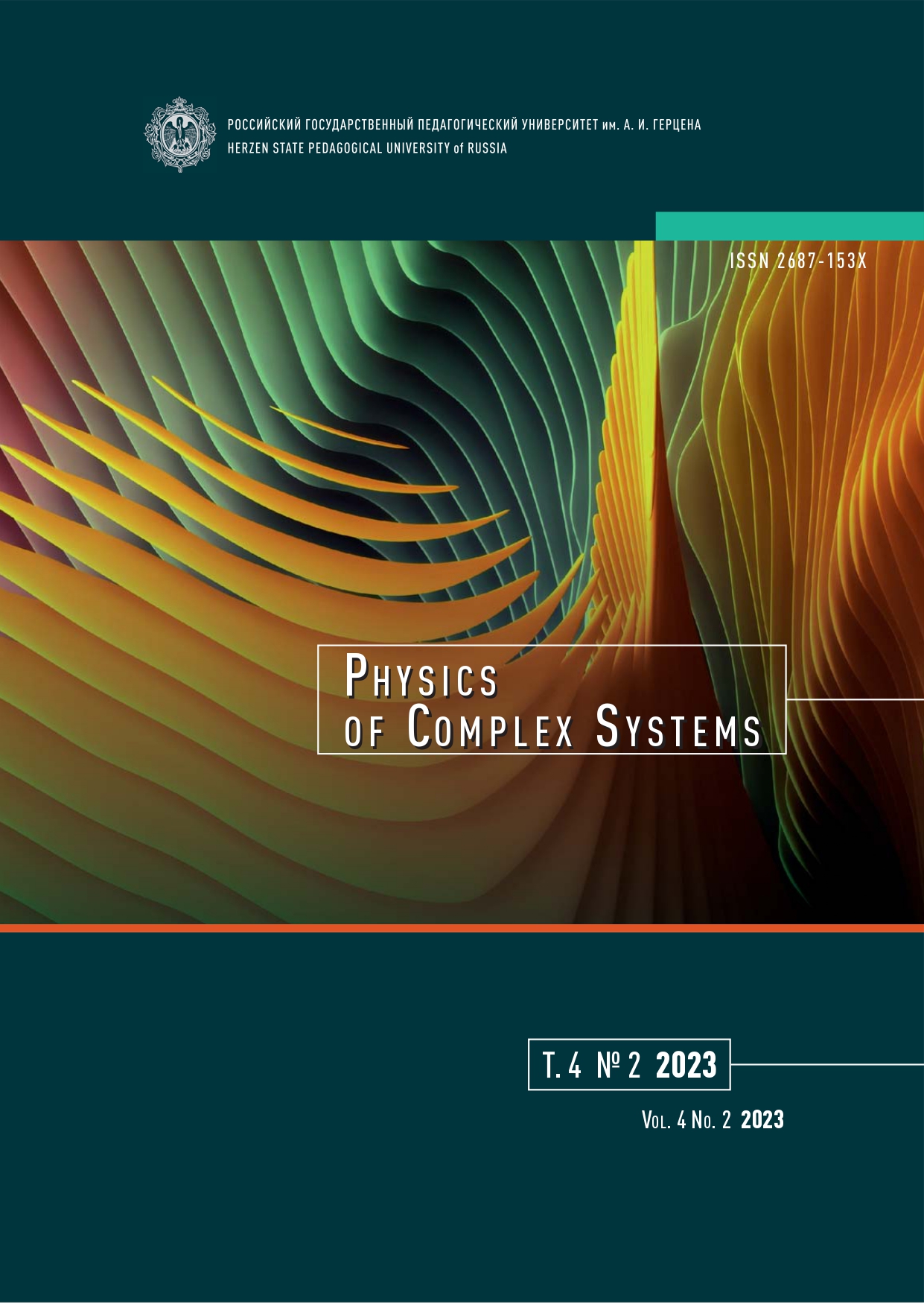Spherulitic microstructure of thin PZT films
DOI:
https://doi.org/10.33910/2687-153X-2023-4-2-81-87Keywords:
PZT thin films, spherulitic microstructure, optical second harmonic generation, mechanical stresses, induced polarizationAbstract
The paper shows that the formation of a radiant spherulites microstructure in lead zirconate-titanate thin films obtained by radio-frequency magnetron sputtering is associated with the formation of radial tensile mechanical stresses acting in the substrate plane, the magnitude of which increases with increasing linear size of spherulites. It leads to a change in the lattice parameter of the perovskite structure and the appearance of induced polarization, the value of which can significantly exceed the spontaneous polarization.
References
Alkoy, E. M., Alkoy, S., Shiosaki, T. (2007) The effect of crystallographic orientation and solution aging on the electrical properties of sol-gel derived Pb(Zr0.45Ti0.55)O3 thin films. Ceramic International, 33 (8), 1455–1462. https://doi.org/10.1016/j.ceramint.2006.06.010 (In English)
Brewster, D. (1815) III. Experiments on the depolarisation of light as exhibited by various mineral, animal, and vegetable bodies, with a reference of the phenomena to the general principles of polarisation. By David Brewster, LL. D. F. R. S. Edin and F. S. A. Edin. In a letter addressed to the Right Hon. Sir Joseph Banks, Bart. K. B. P. R. S. Philosophical Transactions, 105, 29–53. https://doi.org/10.1098/rstl.1815.0004 (In English)
Brewster, D. (1853) XLIII.-On Cricular Crystals. Earth and Environmental Science. Transactions of the Royal Society of Edinburgh, 20 (4), 607–623. https://doi.org/10.1017/S0080456800033895 (In English)
Cross, W. (1891) Constitution and origin of spherulites in acid eruptive rocks. Bulletin of the Philosophical Society of Washington, 11, 411–502. (In English)
Dolgintsev, D. M., Senkevich, S. V., Kaptelov, E. Yu. et al. (2021) Microstructure and properties of polycrystalline PZT films obtained by RF magnetron sputtering with fine variation of the composition near morphotropic phase boundary. Physics of Complex Systems, 2 (3), 101–109. https://www.doi.org/10.33910/2687-153X-2021-2-3-101-109 (In English)
Elshin, A. S., Pronin, I. P., Senkevich, S. V., Mishina, E. D. (2020) Nonlinear optical diagnostics of thin polycrystalline lead zirconate titanate films. Technical Physics Letters, 46 (4), 385–388. https://doi.org/10.1134/S1063785020040215 (In English)
Elshin, A. S., Staritsyn, M. V., Pronin, I. P. et al. (2023) Nonlinear optics for crystallographic analysis in lead zirconate titanate. Coatings, 13 (2), article 247. https://doi.org/10.3390/coatings13020247 (In English)
Izyumskaya, N., Alivov, Y.-I., Cho, S.-J. et al. (2007) Processing, structure, properties, and applications of PZT thin films. Critical Reviews in Solid State and Materials Sciences, 32 (3-4), 111–202. https://doi.org/10.1080/10408430701707347 (In English)
Kantor, B. Z. (1997) Besedy o mineralakh [Conversations about minerals]. Moscow: Astrel Publ., 131 p. (In Russian)
Klee, M., de Veirman, A., Taylor, D. J., Larsen, P. K. (1994) Structure-property relations in polycrystalline titanate thin films. Integrated Ferroelectrics, 4 (3), 197–206. https://doi.org/10.1080/10584589408017022 (In English)
Kukushkin, S. A., Tentilova, I. Y., Pronin, I. P. (2012) Mechanism of the phase transformation of the pyrochlore phase into the perovskite phase in lead zirconate titanate films on silicon substrates. Physics of the Solid State, 54 (3), 611–616. https://doi.org/10.1134/S1063783412030158 (In English)
Lutjes, N. R., Zhou, S., Antoja-Lleonart, J. et al. (2021) Spherulitic and rotational crystal growth of Quartz thin films. Scientific Reports, 11, article 14888. https://doi.org/10.1038/s41598-021-94147-y (In English)
Muralt, P., Polcawich, R. G., Trolier-McKinstry, S. (2009) Piezoelectric thin films for sensors, actuators, and energy harvesting. MRS Bulletin, 34 (9), 658–664. https://doi.org/10.1557/mrs2009.177 (In English)
Musterman, E. J., Dierolf, V., Jain, H. (2022) Curved lattices of crystals formed in glass. International Journal of Applied Glass Science, 13 (3), 402–419. https://doi.org/10.1111/ijag.16574 (In English)
Preston, K. D., Haertling, G. H. (1992) Microstructural investigation of acetate-derived PLZT films. Integrated Ferroelectrics, 1 (1), 89–98. https://doi.org/10.1080/10584589208215567 (In English)
Pronin, V. P., Dolgintsev, D. M., Osipov, V. V. et al. (2018) The change in the phase state of thin PZT layers in the region of the morphotropic phase boundary obtained by the RF magnetron sputtering with varying target-substrate distance. IOP Conference Series: Materials Science and Engineering, 387, article 012063. https://doi.org/10.1088/1757-899X/387/1/012063 (In English)
Pronin, V. P., Senkevich, S. V., Kaptelov, E. Yu., Pronin, I. P. (2010) Features of the formation of a perovskite phase in thin polycrystalline Pb(Zr,Ti)O3 films. Journal of Surface Investigation. X-ray, Synchrotron and Neutron Techniques, 4, 703–708. https://doi.org/10.1134/S1027451010050010 (In English)
Shtukenberg, A. G., Punin, Yu. O., Gunn, E., Kahr, B. (2012) Spherulites. Chemical Reviews, 112 (3), 1805–1838. https://doi.org/10.1021/cr200297f (In English)
Song, L., Glinsek, S., Defay, E. (2021) Toward low-temperature processing of lead zirconate titanate thin films: Advances, strategies, and applications. Applied Physics Reviews, 8 (4), article 041315. https://doi.org/10.1063/5.0054004 (In English)
Talbot, W. H. F. (1837) III. On the optical phenomena of certain crystals. Philosophical Transactions, 127, 25–27. https://doi.org/10.1098/rstl.1837.0005 (In English)
Wang, J.-S., Jin, K.-J, Gu, J.-X. et al. (2017) Direct evidence of correlation between the second harmonic generation anisotropy patterns and the polarization orientation of perovskite ferroelectric. Scientific Reports, 7, article 9051. https://doi.org/10.1038/s41598-017-09339-2 (In English)
Downloads
Published
Issue
Section
License
Copyright (c) 2023 Vladimir P. Pronin, Stanislav V. Senkevich, Andrey S. Elshin, Elena D. Mishina, Igor P. Pronin

This work is licensed under a Creative Commons Attribution-NonCommercial 4.0 International License.
The work is provided under the terms of the Public Offer and of Creative Commons public license Creative Commons Attribution 4.0 International (CC BY 4.0).
This license permits an unlimited number of users to copy and redistribute the material in any medium or format, and to remix, transform, and build upon the material for any purpose, including commercial use.
This license retains copyright for the authors but allows others to freely distribute, use, and adapt the work, on the mandatory condition that appropriate credit is given. Users must provide a correct link to the original publication in our journal, cite the authors' names, and indicate if any changes were made.
Copyright remains with the authors. The CC BY 4.0 license does not transfer rights to third parties but rather grants users prior permission for use, provided the attribution condition is met. Any use of the work will be governed by the terms of this license.







